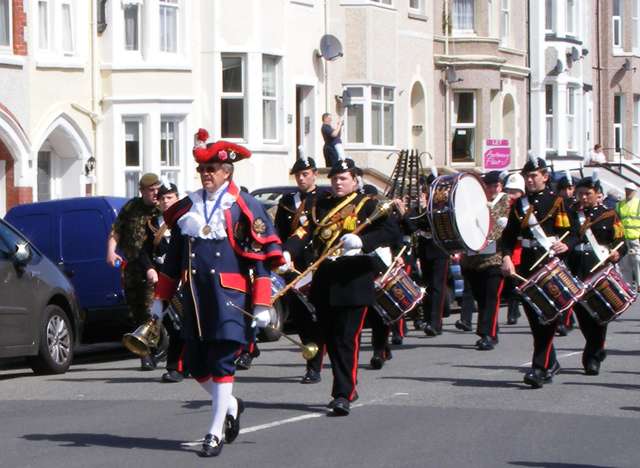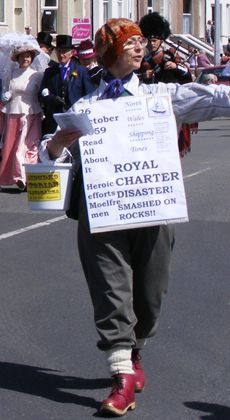In the
Mid-day Parade - Saturday 2 May 2009

 In the middle of photographing Saturday's
parade
an interesting pamphlet was given to me. It is a memorial sonnet
recalling the sad loss at sea, off the coast of Anglesey, in
1859 of the "Royal Charter" a 2719 ton steel built steam
clipper of 1851 en-route from Australia to Liverpool with about
371 passengers (but designed to carry 600 passengers) and 112
crew on board.
In the middle of photographing Saturday's
parade
an interesting pamphlet was given to me. It is a memorial sonnet
recalling the sad loss at sea, off the coast of Anglesey, in
1859 of the "Royal Charter" a 2719 ton steel built steam
clipper of 1851 en-route from Australia to Liverpool with about
371 passengers (but designed to carry 600 passengers) and 112
crew on board.
Reported with Thanks.
The rescue at Moelfre was the work of a Victorian lifeboat crew. Their station with its rowing boats had been established in the 1840's.

SUPPORT
THE LIFEBOATS
and - should you need it -
THE LIFEBOATS WILL SUPPORT YOU
The Royal
Charter ran aground during the great storm on October 25th
1859. Returning from the Australian Goldfields through
Melbourne in one of the finest ships afloat, the passengers were
within hours of their destination port of Liverpool, soon after failing
to take on board the Liverpool Pilot at Point Lynas, when the storm
blew
the ship onto the rocky shore nearby at Moelfre, just 20 miles from the
Great Orme at Llandudno. This is the largest
recorded single shipwreck loss of life off the Coast of Wales.
Maltese
crew member, Guze Ruggier, born 1828 and known as Joseph Rogers,
exhibiting the utmost bravery swam through the battering storm taking a
line from ship to shore. A bo'sun's chair was rigged. Twenty-eight men
from the Anglesey village of Moelfre walked into the sea, to form a
human chain of rescue.
Some 450
or more
people died that night and just 41 were rescued. Bodies floated in on
the
waves into rocky coves and sandy beaches right across the north coast
of Anglesey. Not one woman or child could be saved.
The Reverend Steven Roose Hughes, painstakingly wrote to the
families of every person who had died. Joseph Rogers was awarded the
Royal National Lifeboat Institution (RNLI) Gold Medal.
Passengers, who had become rich with their exertions in the
Goldflelds, had sewn their gold into their clothing to keep it safe and
that left them heavy and vulnerable to the sea.
________________________________________________________________________
As I photographed her
presence
in the Extravaganza Parade,
Miss Charlotte Peters Rock,
a one woman crusade,
charmingly bore down upon me
and thrust into my sticky hand this sonnet grand
- recalling that great loss of yesteryear.
in the Extravaganza Parade,
Miss Charlotte Peters Rock,
a one woman crusade,
charmingly bore down upon me
and thrust into my sticky hand this sonnet grand
- recalling that great loss of yesteryear.
________________________________________________________ Noel Walley.
Royal
Charter (song) 1859
Australia - back
across the sea
The Royal Charter brought the people home
To Liverpool where they will always be
Remembered well although they didn't come
The Royal Charter brought the people home
To Liverpool where they will always be
Remembered well although they didn't come
One autumn night
in 1859
A storm blew up - the worst that century
The Royal Charter wrecked just off the coast
Near Dulas Bay and close to Red Wharf Bay
A storm blew up - the worst that century
The Royal Charter wrecked just off the coast
Near Dulas Bay and close to Red Wharf Bay
Joe Rodgers swam
to bring a line ashore
He fought the waves and rocks that dreadful day
The Royal Charter wrecked just off the coast
Near Dulas Bay and close to Red Wharf Bay
He fought the waves and rocks that dreadful day
The Royal Charter wrecked just off the coast
Near Dulas Bay and close to Red Wharf Bay
A bo'sun's chair
was rigged to save the lives
A human chain was paid out in the sea
The Royal Charter wrecked just off the coast
Near Dulas Bay and close to Red Wharf Bay
A human chain was paid out in the sea
The Royal Charter wrecked just off the coast
Near Dulas Bay and close to Red Wharf Bay
Just forty-one
were rescued from the ship
Four hundred - near five hundred - died that day
The Royal Charter wrecked just off the coast
Near Dulas Bay and close to Red Wharf Bay
Four hundred - near five hundred - died that day
The Royal Charter wrecked just off the coast
Near Dulas Bay and close to Red Wharf Bay
The Moelfre
twenty-eight men were so brave
The Rector Steven Roose Hughes broke his heart
Recording all the ones they could not save
For relatives who waited at the port
The Rector Steven Roose Hughes broke his heart
Recording all the ones they could not save
For relatives who waited at the port
The Royal Charter
- full of lives and gold
In sight of land was wrecked by raging wave
The bodies washed ashore were dead and old
Along the coast - with no more left to save (reply)
In sight of land was wrecked by raging wave
The bodies washed ashore were dead and old
Along the coast - with no more left to save (reply)
Moral
Returning home
from Goldfields in the south
Don't sew the weight of gold in hem or seam
Shipwrecked you'll drown as water fills your mouth
Your 'rich return' a thwarted distant dream.
Don't sew the weight of gold in hem or seam
Shipwrecked you'll drown as water fills your mouth
Your 'rich return' a thwarted distant dream.
Reported with Thanks.
The aftermath of the disaster is described by Charles Dickens in The Uncommercial Traveller. Dickens visited the scene and talked to the rector of Llanallgo, the Rev. Stephen Hughes, whose exertions in finding and identifying the bodies may have led to his own premature death soon afterwards. Dickens gives a vivid illustration of the force of the gale:
- So tremendous had the force of the sea been when it broke the ship, that it had beaten one great ingot of gold, deep into a strong and heavy piece of her solid iron-work: in which also several loose sovereigns that the ingot had swept in before it, had been found, as firmly embedded as though the iron had been liquid when they were forced there.
The rescue at Moelfre was the work of a Victorian lifeboat crew. Their station with its rowing boats had been established in the 1840's.

and - should you need it -
THE LIFEBOATS WILL SUPPORT YOU
